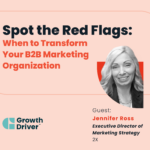The shift to online anonymity has undoubtedly hit sales the hardest in the world of B2B. While some are complaining about the ineffectiveness of intent data, demanding contact information must be known to chase leads, others will be seizing this time to align with new buyer behavior and reap the rewards.
At its core, this shift is forcing B2B teams to focus efforts where they matter most, with aligned goals across the entire revenue team. Marketing and sales will have to work together to accurately identify which leads are ready for follow up, and enable buying teams until they are.
Enable buyers and un-gate your content
Before you gate something, really ask yourself how bad you want to gate that. When accounts are in that crucial phase where they’re making decisions, it’s critical to enable those buying teams better than your competitors. You want to make their decision as frictionless as possible.
Buying teams need to be convinced as a group. Any way you make it more difficult for them to work their process will deter them from buying from you. Remember, buyers are 70% of the way through their buying process by the time they make contact–which they do 83% of the time. If another vendor is enabling that buying group better than you, the remaining 30% of their journey is plenty of time to sway their decision. This means that buyers must have all the content they’ll need to help them choose you, otherwise they may not talk to your reps at all.
Lonely leads aren’t worth chasing
While the shift to online anonymity has seemingly made it more difficult for sellers to know exactly who is engaging with their content, this has created an opportunity for smarter, more efficient allocation of time and resources. This is where intent data comes in.
If one lead from an account has consumed content in the last 30 days, it doesn’t matter how much content they’ve engaged with. If they came alone, they’re not worth chasing. Now, if that account has two or three leads engaging with your content, you’ve probably got a buying team of 10 people on your website. 6sense reports that three out of ten people from a buying team will fill out a form, which tells us that the other seven are on your website anonymously.
Chasing leads just isn’t worth it anymore. Instead, roll up intent data to the account level and offer those contacts heavy-weight HVOs. The common thread running through this entire shift is that sellers have to put value and experiences first, and their products second or even third. This is a hard thing for traditional B2B marketers and sellers to do. But what this data is clearly saying is you have to do it.
Rethink the way you view SDR functions
The accounts that do reach out are where your efforts should be focused most, but that’s not to say sellers should sit around and wait until the invite comes. Sales functions have always been very focused in the short term, but with buying cycles becoming longer and anonymity, it’s time we rethink the way we use the SDR function.
SDRs should be adding value to the purchase experience and enabling buying groups. It’s a mindset shift – from catching to connecting, from pursuing to providing. Considering only a small fraction of your ICP is actually in market at any given time, there is no sense in selling to prospects that literally have no immediate intention of buying.
Chasing leads will only alienate the people who will become potential buyers at some point. Leave them alone until they’ve asked you to contact them, and use your SDRs to make sure your prospects know about every possible way you can provide value to them when the account is actually in-market.
Where do you spend your time?
We know that buyers are really buying groups today, and while a single lead shouldn’t be undervalued, the strongest signal of a potential buying decision is collective interest.
Consider the logic of it. One person filled out a form and nobody else from their account has been on your website. You’ve got another account where one person filled out a form and five other people who’ve been on the website anonymously.
Where do you spend your time? You don’t have to be in B2B to get that answer right.




